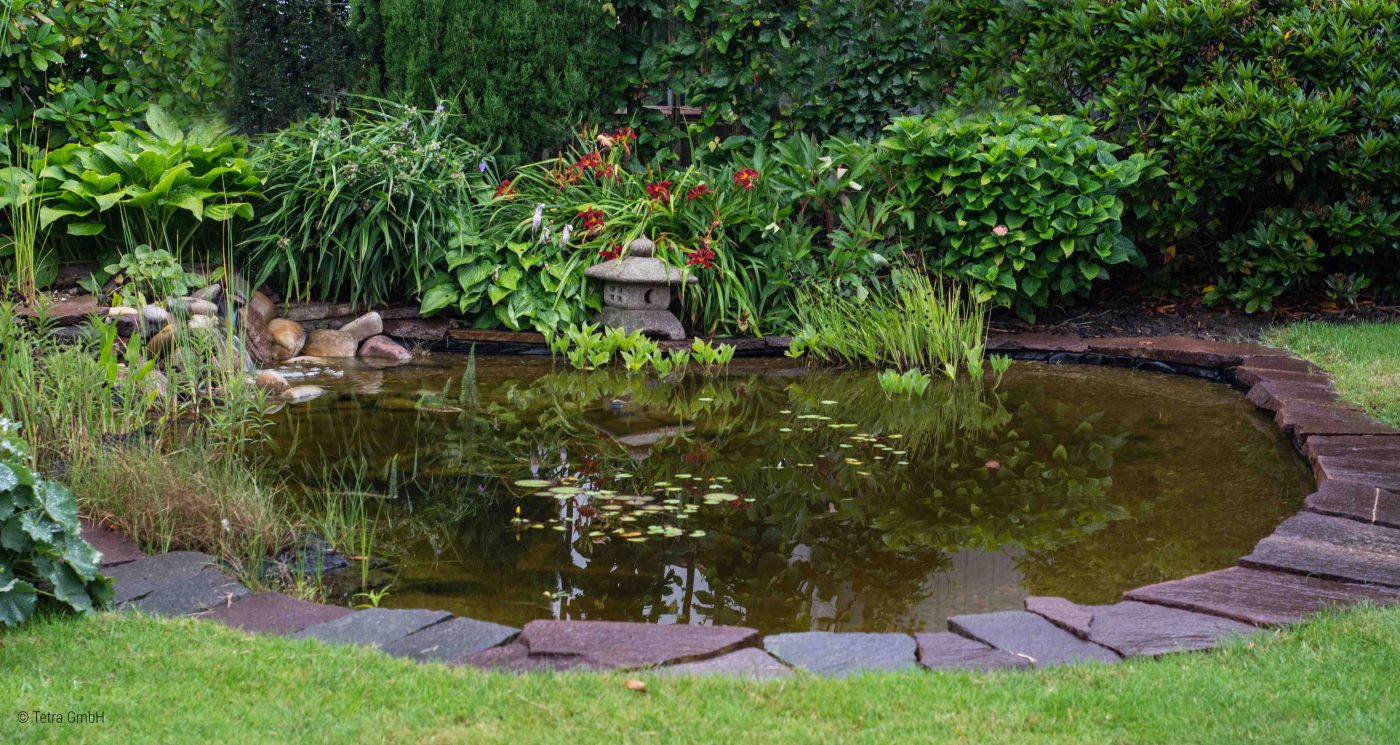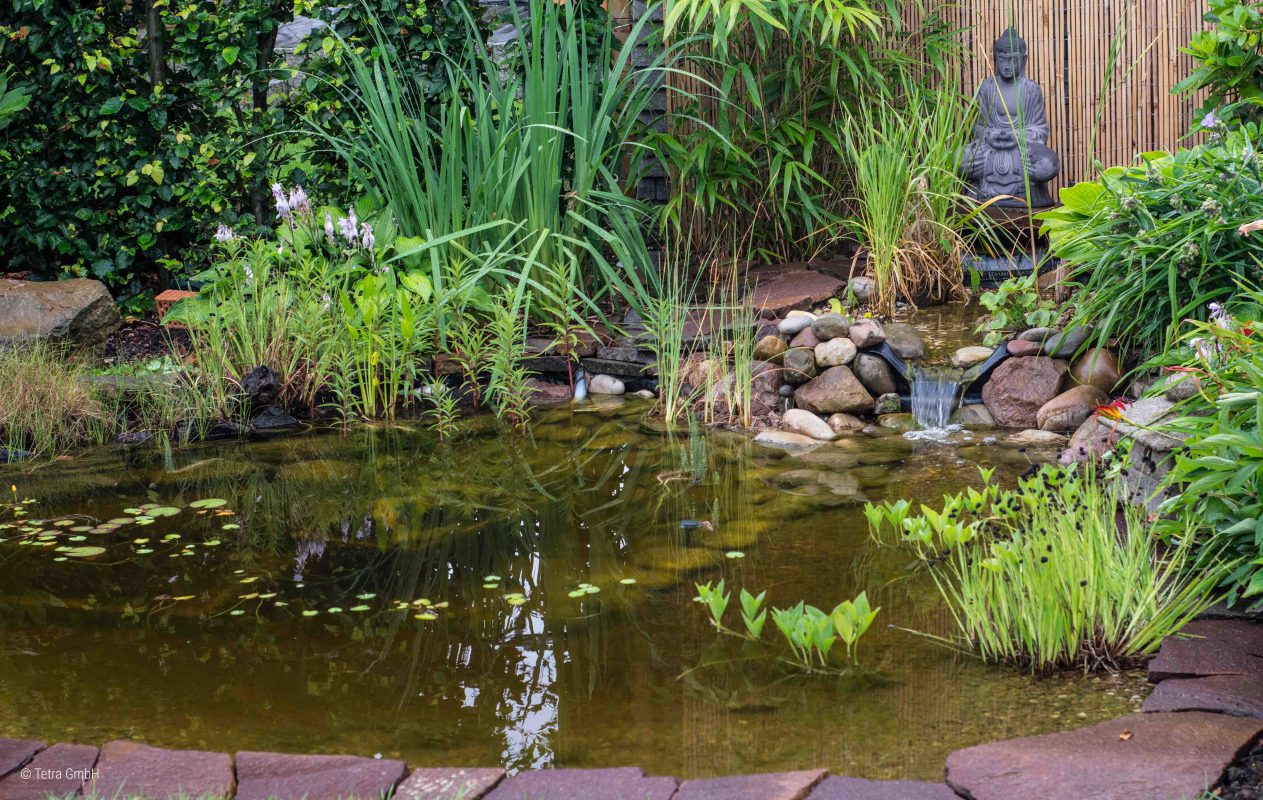Fish swimming around, lush greenery, dragonflies hovering over the water… Who wouldn’t want to own a pond and enjoy the wonders of nature? A well-tended pond is a beautiful sight to behold and the perfect place for relaxing in the garden.
If you care for it properly, your pond will maintain an optimum biological balance and offer your fish a comfortable home. However, the care measures for your pond vary from one season to the next. For example, in autumn it’s important to gradually prepare your pond for winter and in spring, to get it back in shape again so that you can enjoy it to the full in summer. Find out here about which care measures your pond needs all year round.
Pond care in spring
Once the frosts are over, the flowers start blossoming in the warm sunlight and the fish wake from their hibernation due to the rising water temperatures, it’s also time for you to rouse your pond from its winter slumber.
As soon as your fish start to stir and become active, you should begin feeding them again. If the water temperatures are still below 10°C you should start by feeding them energy-optimised food that contains a balanced mix of vitamins, nutrients and trace elements. As your fish are not in peak form after the winter and are therefore more vulnerable to disease, it is important to help them get back into shape again quickly and to boost their energy reserves. Tetra Pond Wheatgerm Sticks are ideal for this purpose as they are easy to digest for your fish, even in low temperatures. Once the water temperature rises above 10°C in the long term, you can switch to normal, top-quality, high-energy food.
Please note that you shouldn’t start “spring cleaning” your pond until your fish have finished hibernating. The first step is to check the edge of the pond for any damage sustained during the winter and to repair it if necessary. If you have stored your technical equipment in a frost-proof location over the winter, now is the time to put it back in your pond and check it: are your pond pumps still working perfectly and is your filter’s flow rate sufficient? It’s important to put the filter back into your pond in good time so that it can become biologically active again and enough microorganisms can settle on it to help clean the pond water.
Green water is a common occurrence in spring, as this is the time of year when most algae problems crop up. Plant growth is not yet vigorous enough to counter any algae and compete with them for nutrients. This doesn’t happen until later in the year. It’s therefore crucial to ensure good water quality and clear water in spring. For this purpose, you should check the key water values, such as carbonate hardness, pH and nitrate levels, on a regular basis using the Tetra Pond Test 6in1. If an algae problem arises, you can combat it with algaecides or a UVC clarifier in the filter circuit. The latter eliminates floating algae, which turn the pond water green.
The main cause of algae growth is an excessive nutrient content in the water. This can arise, inter alia, due to an accumulation of sludge at the bottom of the pond during the winter months. If this is the case, you also need to remove this sludge-like deposit. Be very careful to avoid overstressing your active fish during the mulm-removal process. Other ways of reducing the nutrient content include carrying out partial water changes and making appropriate use of pond treatments. In late spring, you can also add some new plants or some water lilies, for example.
Pond care in summer

After all your hard work in spring, now it’s time to enjoy the full splendour of your garden pond. Your plants have grown sufficiently in the meantime and are currently competing with algae for nutrients, thereby reducing or inhibiting algae growth. If, however, algae do proliferate, simply fish them out with a dip net or use a special anti-algae agent. If your plant growth is too dense, simply thin out your plants and remove any dead plant parts with a dip net from time to time.
Don’t forget to check the water values at certain intervals and to keep an eye on the water temperature. In warm water, less oxygen can be dissolved so we recommend additionally aerating your pond to increase the oxygen level. You can do so by adding a water feature, for example. If the water level falls due to excessive evaporation, you will need to top up your pond. When doing so, you should always use a water conditioner to make the water safe for fish. Carrying out a partial water change is another good way of guaranteeing good water quality. What’s more, you can use the extracted pond water to water your flowers, for example.
Pond care in autumn
The days are drawing in and the temperatures are falling. Autumn is approaching, so now is the time to prepare your pond for the winter. It is crucial to clean and care for your pond in autumn to help your pond and fish make it through the winter in good shape.
In autumn, you should regularly remove any leaves fallen from trees as well as any plant remains and foliage from the water surface, otherwise they will sink to the bottom of your pond and gradually create an ever thicker layer of sediment. Covering your pond with a leaf net could be a great help here, particularly for smaller ponds. Cut your pond plants back and remove any weeds and dead plants.
Good water quality is crucial in order for your fish to remain healthy over winter. You should therefore remove any excess sludge and sediment from the bottom of your pond using a pond vacuum. Partial water changes are also essential in preparation for winter as they help to prevent poor water quality and keep the nutrient content in check, thereby preventing the risk of prolific algae growth in spring. You should therefore check the key water values on a regular basis in autumn.
In late autumn, before the first frosts, you should remove any external filters and pumps from the water. Once you have cleaned them properly, you can store them in a frost-free area over winter.
While it is still warm and your fish are still active, you should continue to feed them high-energy foods so that they can build up sufficient energy reserves for the winter. Once the water temperatures fall below 10°C, you should start feeding your fish Tetra Pond Wheatgerm Sticks to prevent them from having to live off their winter reserves before they hibernate and to shorten their non-feeding period.
Pond care in winter
The water in your pond can be broken down into layers, to some extent. In cold weather, fish remain in the bottom water layer as the water temperature is higher there than directly at the water surface.
If you use a pump or an aerator to keep your pond free from ice, you must make sure it is placed in a shallow area, otherwise it will recirculate all of the water. This would destroy the layering of the water which is crucial for your fish to survive. When placed in shallow areas, ice preventers just keep a small hole free from ice, but that’s perfectly sufficient to enable a gas exchange.
If the rest of your pond freezes over and a thick layer of ice forms, leave it alone and don’t hack into the ice. You should also avoid walking on your frozen pond as this causes a great deal of stress for your fish. Since your fish have very good hearing you could startle them during hibernation and make them want to flee. This could have fatal consequences, as they wouldn’t be in a fit state to escape due to their slowed metabolism. That is why hibernation not only applies to your fish, but to your entire pond.
If your pond is not covered in ice due to a mild winter and your fish start to stir, continue feeding them Tetra Pond Wheatgerm Sticks.
These tips will help you get your fish safely through the winter until spring approaches and the pond care cycle starts all over again.

